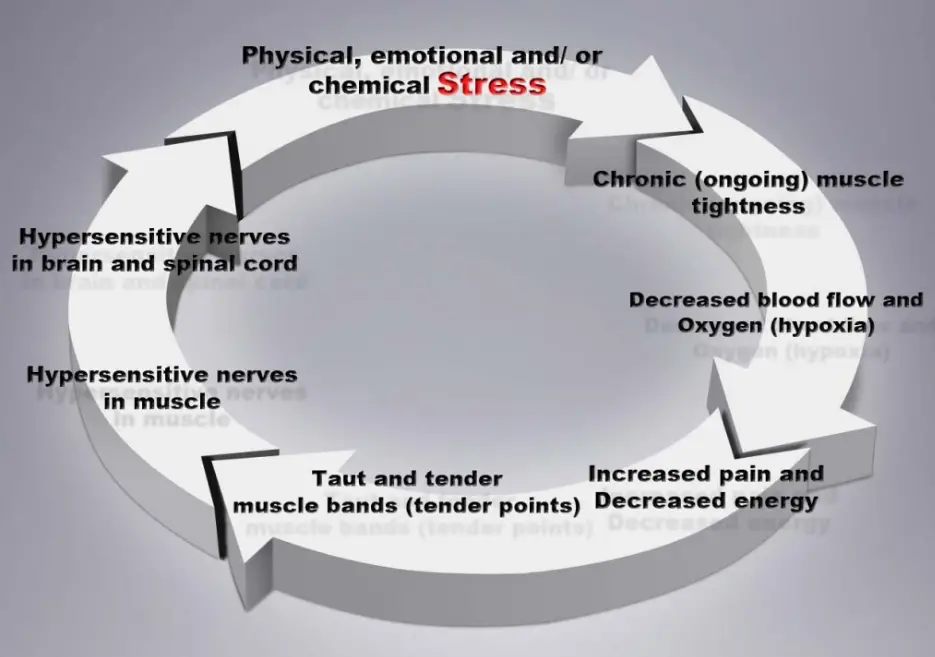What Does Fibromyalgia Pain Feel Like?
If you are reading this it is likely that you or a loved one already know that Fibromyalgia is a real and disabling chronic pain condition. What you may not know is that Fibromyalgia, as part of the larger category of Myofascial Pain Syndromes, affects over 105 million Americans. That’s more people than the entire population of Detroit, Michigan.
Equally shocking is the fact that 50 million of its sufferers are rendered partially or even totally disabled. Obviously, this is a real and widespread problem that needs to be addressed.
As previously stated, pain is the primary symptom of this disorder. The pain is located all over the body and unlike the regular pain from injury; it persists unrelentingly for a minimum of three months. In most cases, the pain persists for years or even decades. This pain is usually experienced as a deep muscle pain that has been described as aching, radiating, shooting, gnawing, burning, exhausting, nagging, and muscles that feel very tender to the touch. For some people, the pain and stiffness are much worse in the morning and gets better during the day only to worsen again at night. Unfortunately, some people have non-stop pain throughout the day.
Clinically, I have noticed that Fibromyalgia sufferers are more sensitive to temperature and humidity changes than those without this condition. In addition, I have noticed that even unusual stressors such as electromagnetic and gravitational changes (a full moon or lunar eclipse) can exacerbate the pain of this condition.
In conjunction with the overall pain described above, people with Fibromyalgia also experience specific “tender points” in their body that are very painful to the touch. These specific points, sometimes called “trigger points”, are located in:
- The front and back of the neck.
- The mid and upper back of the shoulders.
- Upper chest.
- Elbows.
- Upper buttocks.
- Hips.
- Knees
Besides the presence of Pain, other common symptoms of Fibromyalgia include:
- Fatigue.
- Disturbed sleep (Especially a decrease in the deep sleep cycle).
- Headaches.
- Chest pain.
- Dizziness.
- Menstrual cramps.
- Mood changes, depression, and anxiety.
- Gastrointestinal disturbances such as irritable bowel syndrome
Mechanism of Fibromyalgia Pain
The Detailed Mechanism of Fibromyalgia Pain:
In review, remember stress adversely affects two major regions of the body in Fibromyalgia.
- The muscle fiber itself, which results in decreased energy production and pain.
- The nerves that carry that pain to the brain through the spinal cord resulting in increased sensitivity to that pain and a vicious cycle of escalating discomfort.
With that background, let’s now look at the exact mechanism that creates Fibromyalgia.
NOTE: Refer to fig.1

- Stress (physical, chemical and/or emotional) causes chronic (ongoing) muscle fiber contractions (knots). The next time you are in a stressful situation such as a traffic jam or when you are late for an appointment notice how your muscles tighten. This is an example of emotional stress.
- The contracted muscle fibers clamp down on the blood vessels. This restricts blood flow and therefore restricts oxygen. This condition (hypoxia) causes pain within the muscle and also severely decreases the muscle’s energy supply. Note that the energy supply in the muscle is a substance known as ATP.
To compensate for this decreased ATP, the cells use a different chemical reaction to produce energy. This different chemical pathway results in abnormally high concentrations of waste products including pyruvate and lactic acid.
Lactic acid is the chemical that makes you sore after a workout. It can be especially harmful if biochemical problems like deficiencies or toxins are present.
The body responds to the need for more energy by breaking down its own muscle fibers to increase glucose production which is needed for energy production. (ATP)
Therefore, decreased oxygen is a primary cause of both decreased energy and muscle pain.
- Given the fact that it takes ATP energy for the muscle to both contracts and relaxes, the lack of energy (ATP) makes it impossible for the muscle fiber to relax. This leads to the formation of a taut muscle band.
- Additional stresses (mechanical, chemical or emotional) will create a very painful spot called a trigger point in the affected muscle.
IMPORTANT– this trigger point is not only tight and painful, but it has abnormal pain sensors which are hypersensitive and become more sensitive to the pain over time. It is as if the body is saying “Hey, stop dumping all of this stress on me! Since you are not listening, I will continue to become more painful until you do listen to me.”
- These hypersensitive pain receptors then bombard the spinal cord and brain with excessive pain signals, which once again result in abnormal sensitization of the brain and spinal cord. This is called central sensitization and is sometimes referred to as pain memory. What this means is a small amount of irritation or pain will create a whole lot of pain in the brain and spinal cord. The more pain it receives, the more sensitive it gets.
- Finally, if the above was not bad enough, these trigger points in the muscle can then create satellite trigger points and spread the condition to other areas of the body.
Guess what, this creates more stress and pain which feeds the cycle all over again.
THIS IS THE VICIOUS CYCLE OF PAIN AND FATIGUE WE KNOW AS FIBROMYALGIA.
Now before you get discouraged and add even more stress to your situation, there is some good news.
Just as chronic stress can create this vicious cycle, decreasing stress and substituting good factors (physical, chemical and emotional) into the body can reverse the situation and return the cycle back towards normal.
See: How To Know If You Have Fibromyalgia
What Does Fibromyalgia Pain Feel Like? Last Update: 31/5/2017



Pingback: Sore Buttock Muscles Causes: Curing your buttock pain starts with finding the cause - Body Pain Tips